英语动词时态归纳总结对照表
动词时态语态一览表 → 动词时态用法一览表

动词时态语态一览表→ 动词时态用法一览表动词时态用法一览表一般现在时 (Simple Present)- 描述经常性行为、惯或广泛真理:- I go to the gym every morning. (我每天早上去健身房。
)- The sun rises in the east. (太阳从东方升起。
)- 描述客观事实或普遍规律:- Water boils at 100 degrees Celsius. (水在100摄氏度沸腾。
) - Cats have four legs. (猫有四条腿。
)- 描述日程安排或固定时间表:- The train departs at 10:00 AM. (火车在上午10点发车。
)- The meeting starts in ten minutes. (会议将在十分钟后开始。
) 进行时 (Present Continuous)- 描述目前正在进行的动作:- She is studying for her exams. (她正在备考。
)- They are playing football in the park. (他们正在公园踢足球。
) - 表示暂时的行为状态:- He's staying at his friend's house for the weekend. (他本周末在朋友家住。
)- I'm working on a project right now. (我现在正在做一个项目。
) 现在完成时 (Present Perfect)- 表示过去发生的动作对当前有影响:- I have finished my homework, so I can watch TV. (我已经完成作业了,所以可以看电视。
)- They have been to Paris several times. (他们已经去过巴黎好几次了。
)- 描述经验或成就:- She has won many awards in her career. (她在她的职业生涯中赢得了许多奖项。
英语动词时态总结表格
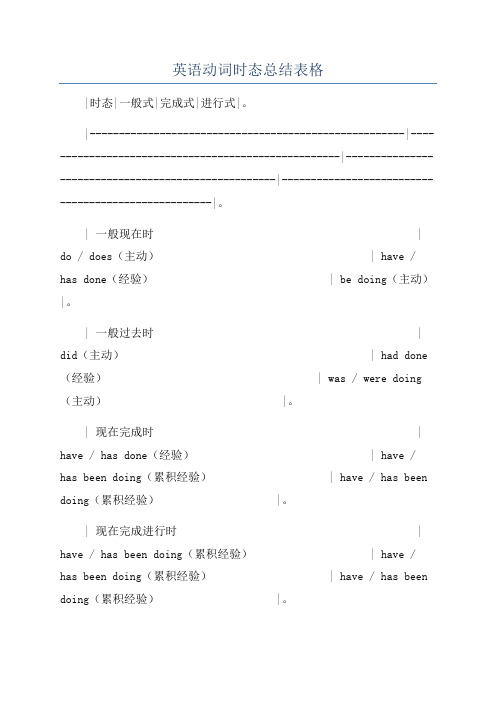
英语动词时态总结表格|时态|一般式|完成式|进行式|。
|------------------------------------------------------|----------------------------------------------------|----------------------------------------------------|----------------------------------------------------|。
| 一般现在时 | do / does(主动) | have / has done(经验) | be doing(主动)|。
| 一般过去时 | did(主动) | had done (经验) | was / were doing (主动) |。
| 现在完成时 | have / has done(经验) | have / has been doing(累积经验) | have / has been doing(累积经验) |。
| 现在完成进行时 | have / has been doing(累积经验) | have / has been doing(累积经验) | have / has been doing(累积经验) |。
| 过去完成时 | had done(经验) | had been doing(累积经验) | had been doing(累积经验) |。
| 过去完成进行时 | had been doing(累积经验) | had been doing(累积经验) | had been doing(累积经验) |。
| 一般将来时 |will / shall do(主动) | will have done(经验) | will be doing(主动)或will have been doing(累积经验) |。
| 进行将来时 |will be doing(主动) | will have been doing(累积经验) | will have been doing (累积经验) |。
(完整版)英语动词时态归纳总结对照表
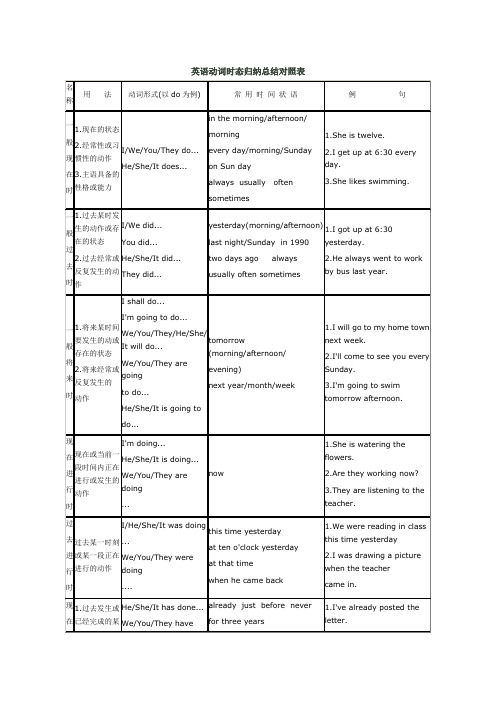
英语动词时态归纳总结对照表英语时态专项练习1、一般现在时。
通常用“usually, often, every day, sometimes”。
一般现在时基本用法介绍一、一般现在时的功能1.表示事物或人物的特征、状态。
如:The sky is blue.天空是蓝色的。
2.表示经常性或习惯性的动作。
如:I get up at six every day.我每天六点起床。
3.表示客观现实。
如:The earth goes around the sun.地球绕着太阳转。
二、一般现在时的构成:肯定句:1).主语+系动词 be(is, am, are )+名词(形容词,介词短语)2) .其他主语+动词原形+其它第三人称单数+动词-s+其它如:I am a boy.我是一个男孩。
We study English.我们学习英语。
Mary likes Chinese.玛丽喜欢汉语。
三、一般现在时的变化否定句:1)主语+ be (is,am,are)+ not +其它。
如:He is not a worker.他不是工人。
2)其他主语+do not(don’t)动词原形+其它I don't like bread第三人称单数+does not(doesn’t)动词原形+其它He doesn't often play.一般疑问句:1)Be(Is,Are) +主语+其它?如:-Are you a student? -Yes. I am. / No, I'm not.2)Do其他主语+动词原形+其它?Does+第三人称单数+动词原形+其它+?注意:遇I/we—you, my—your, some—any.Does she go to work by bike? - Yes, she does. / No, she doesn't.Do you often play football?- Yes, I do. / No, I don't.特殊疑问句:疑问词+一般疑问句。
英语十六种时态表格(附准确例句)
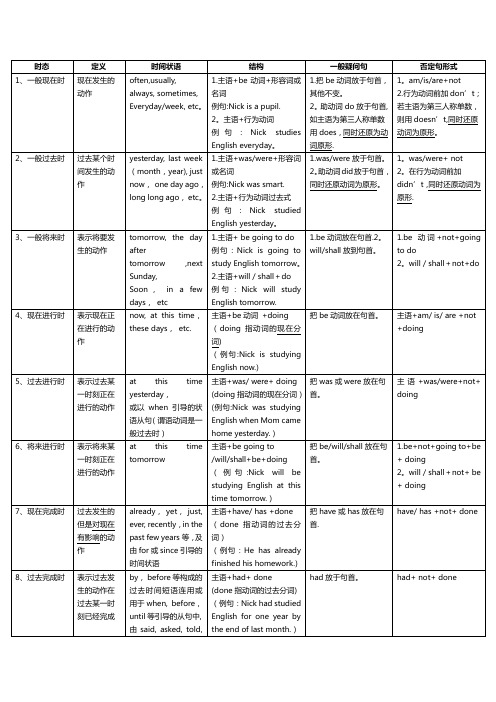
(doing指动词的现在分词)
(例句:Nick is studying English now.)
把be动词放在句首。
主语+am/ is/ are +not +doing
5、过去进行时
表示过去某一时刻正在进行的动作
at this time yesterday,
或以when引导的状语从句(谓语动词是一般过去时)
2。will/shall+not+be + doing
7、现在完成时
过去发生的但是对现在有影响的动作
already,yet,just, ever, recently,in the past few years等,及由for或since引导的时间状语
主语+have/ has +done
(done指动词的过去分词)
1.主语+was/were+形容词或名词
例句:Nick was smart.
2.主语+行为动词过去式
例句:Nick studied English yesterday。
1.was/were放于句首。
2。助动词did放于句首,同时还原动词为原形。
1。was/wLeabharlann re+ not2。在行为动词前加didn’t,同时还原动词为原形.
把will放在句首。
Will + not
13、一般过去将来时
立足于过去某一时刻看将来
常用于宾语从句中
例句:At that timeI knew that Nick would study English。
N/A
Would + not
英语十六时态表格完整总结

going to/will/shall+ shall+have+p,
p( 过 去 分 词 )+其他
Should/would
have done sth
Since+时间点, for+ 时 间段
Hanv/has+be en+doing+ 其 他
1, Was/were+not+going to+do 2, would/should+not+do
过去某一时间对将来 某一时刻以前所会发 生的动作, 常用在虚拟 语气中, 表示与过去的 事实相反 从过去某一时间开始 一直延续到现在的动 作,这一动作可能刚刚 开始, 也可能仍然在继 续,并可能延续到将来
The next day(morning, Year) The following month (week) etc
1,Was/were+ going to+do 2,would/shoul d+do+ 其他
1,Was/were 放于句 首,
2,would/should 提到 句首
Shoud/would +be+ 现 在 分 词
By the time of,by the 主 语 +be
end of+ 时间短语(将 来) by the time+ 从句 (将来)
1.把动词 be 放于句 首。
2.用助动词 do 提问, 如主语为第三人称 单数,则用 does,同 时还原为动词原形。
1.am/is/are+not 2.此时态的谓语动词若为行为动词,则 在其前加 don’;t若主语为第三人称单 数,则用 doesn’,t同时还原行为动词。
动词时态总结一览表

动词时态总结一览表一般现在时(Simple Present)用法:1. 表示经常发生的动作。
- I go to school every day. (我每天去上学。
)2. 表示客观事实、常规或普遍真理。
- The sun rises in the east. (太阳从东方升起。
)3. 表示现在的状态或条件。
- She is a doctor. (她是一名医生。
)一般过去时(Simple Past)用法:1. 表示过去某个时间发生的动作或状态。
- I saw him yesterday. (我昨天见到了他。
)2. 表示过去的惯或经常发生的动作。
- They always played football when they were young. (他们年轻时经常踢足球。
)一般将来时(Simple Future)用法:1. 表示将来要发生的动作。
- I will go to the party tonight. (我今晚要去参加聚会。
)2. 表示打算或意图。
- We are going to visit our grandparents next weekend. (我们打算下个周末去看望我们的祖父母。
)现在进行时(Present Continuous)用法:1. 表示现在正在进行的动作。
- She is studying English at the moment. (她正在研究英语。
)2. 表示近期已经安排好的未来计划。
- I'm meeting a friend for lunch tomorrow. (我明天和一个朋友一起吃午饭。
)过去进行时(Past Continuous)用法:1. 表示过去某个时间正在进行的动作。
- We were watching a movie when the phone rang. (当电话响起时,我们正在看电影。
)2. 表示过去同时发生的动作。
- I was cooking dinner while he was doing his homework. (我正在做晚饭,他正在做作业。
16种英语动词时态表
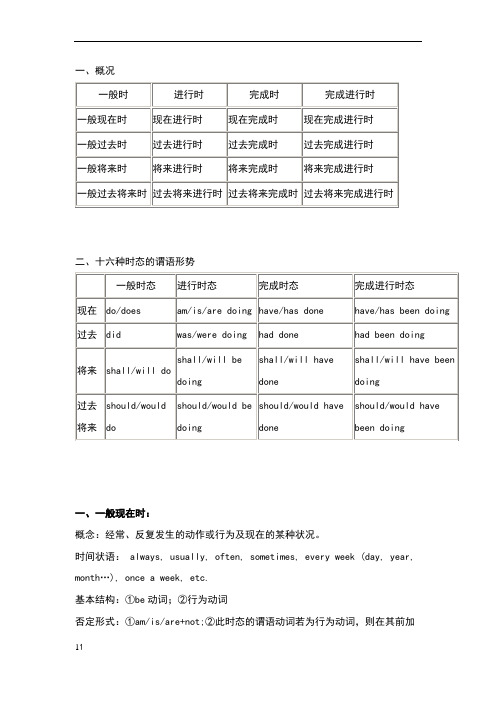
一、概况二、十六种时态的谓语形势一、一般现在时:概念:经常、反复发生的动作或行为及现在的某种状况。
时间状语: always, usually, often, sometimes, every week (day, year, month…), once a week, etc.基本结构:①be动词;②行为动词否定形式:①am/is/are+not;②此时态的谓语动词若为行为动词,则在其前加don't,如主语为第三人称单数,则用doesn't,同时还原行为动词。
一般疑问句:①把be动词放于句首;②用助动词do提问,如主语为第三人称单数,则用does,同时,还原行为动词。
一般现在时主要由动词原形表示,但第三人称单数后要加词尾-s,另外be 和have要根据人称的变化使用特殊的形式。
一般现在时主要表示经常性的动作或存在的状态,还可用来表示普遍真理。
The Yangtze rises in Qinghai. 长江发源于青海。
Actions speak louder than words. 行动胜于言辞。
We have friends all over the world. 我们的朋友遍天下。
二、一般过去时:概念:过去某个时间里发生的动作或状态;过去习惯性、经常性的动作、行为。
时间状语:ago, yesterday, the day before yesterday, last week(year, night, month…), in 1989, just now, at the age of 5, one day, long long ago, once upon a time, etc.基本结构:①be动词;②行为动词否定形式:①was/were+not;②在行为动词前加didn't,同时还原行为动词。
一般疑问句:①was或were放于句首;②用助动词do的过去式did 提问,同时还原行为动词。
英语十六种动词时态归纳表
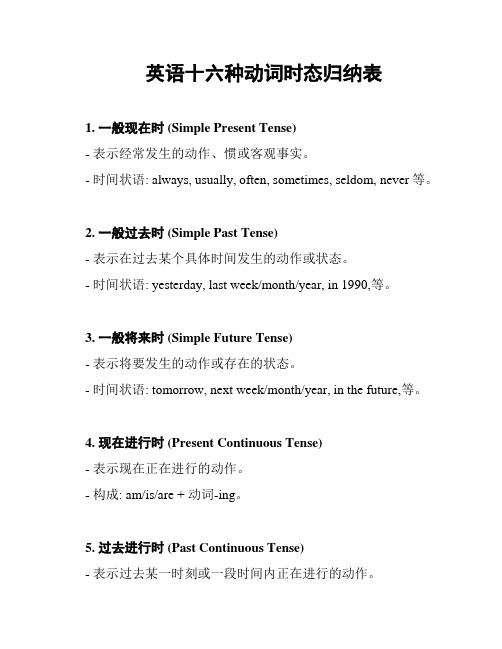
英语十六种动词时态归纳表1. 一般现在时 (Simple Present Tense)- 表示经常发生的动作、惯或客观事实。
- 时间状语: always, usually, often, sometimes, seldom, never等。
2. 一般过去时 (Simple Past Tense)- 表示在过去某个具体时间发生的动作或状态。
- 时间状语: yesterday, last week/month/year, in 1990,等。
3. 一般将来时 (Simple Future Tense)- 表示将要发生的动作或存在的状态。
- 时间状语: tomorrow, next week/month/year, in the future,等。
4. 现在进行时 (Present Continuous Tense)- 表示现在正在进行的动作。
- 构成: am/is/are + 动词-ing。
5. 过去进行时 (Past Continuous Tense)- 表示过去某一时刻或一段时间内正在进行的动作。
- 构成: was/were + 动词-ing。
6. 将来进行时 (Future Continuous Tense)- 表示将来某一时刻或一段时间内正在进行的动作。
- 构成: will be + 动词-ing。
7. 现在完成时 (Present Perfect Tense)- 表示动作对现在造成的影响或状态。
- 构成: have/has + 过去分词。
8. 过去完成时 (Past Perfect Tense)- 表示在过去某一时间点或动作之前已经发生的动作。
- 构成: had + 过去分词。
9. 将来完成时 (Future Perfect Tense)- 表示在将来某一时间点之前将会发生的动作。
- 构成: will have + 过去分词。
10. 现在完成进行时 (Present Perfect Continuous Tense)- 表示从过去某一时刻开始一直延续到现在且可能继续下去的动作或状态。
英语时态语态总结表格

英语时态语态总结表格一、时态总结。
时态名称构成用法例句。
一般现在时主语+动词原形/第三人称单数动词+s/es 表示经常性或习惯性动作,客观真理等 He goes to school by bus every day.一般过去时主语+动词过去式表示过去某个时间发生的动作或状态 Theyvisited their grandparents last Sunday.一般将来时主语+will/shall+动词原形表示将来某个时间要发生的动作或状态We will have a meeting tomorrow.现在进行时主语+be+动词-ing 表示现在正在进行的动作 He is playing football now.过去进行时主语+was/were+动词-ing 表示过去某个时间正在进行的动作 They were watching TV at 8 o'clock last night.将来进行时主语+will be/shall be+动词-ing 表示将来某个时间正在进行的动作We will be having dinner at 7 o'clock tomorrow.现在完成时主语+have/has+动词过去分词表示过去某个时间开始,一直持续到现在的动作或状态 He has lived in this city for 10 years.过去完成时主语+had+动词过去分词表示过去某个时间之前已经发生的动作或状态 They had finished their homework before 9 o'clock yesterday.将来完成时主语+will have/shall have+动词过去分词表示将来某个时间之前已经发生的动作或状态 We will have graduated from college by next year.二、语态总结。
语态名称构成用法例句。
(完整版)英语动词时态归纳总结对照表

英语动词时态归纳总结对照表英语时态专项练习1、一般现在时。
通常用“usually, often, every day, sometimes”。
一般现在时基本用法介绍一、一般现在时的功能1.表示事物或人物的特征、状态。
如:The sky is blue.天空是蓝色的。
2.表示经常性或习惯性的动作。
如:I get up at six every day.我每天六点起床。
3.表示客观现实。
如:The earth goes around the sun.地球绕着太阳转。
二、一般现在时的构成:肯定句:1).主语+系动词 be(is, am, are )+名词(形容词,介词短语)2) .其他主语+动词原形+其它第三人称单数+动词-s+其它如:I am a boy.我是一个男孩。
We study English.我们学习英语。
Mary likes Chinese.玛丽喜欢汉语。
三、一般现在时的变化否定句:1)主语+ be (is,am,are)+ not +其它。
如:He is not a worker.他不是工人。
2)其他主语+do not(don’t)动词原形+其它I don't like bread第三人称单数+does not(doesn’t)动词原形+其它He doesn't often play.一般疑问句:1)Be(Is,Are) +主语+其它?如:-Are you a student? -Yes. I am. / No, I'm not.2)Do其他主语+动词原形+其它?Does+第三人称单数+动词原形+其它+?注意:遇I/we—you, my—your, some—any.Does she go to work by bike? - Yes, she does. / No, she doesn't.Do you often play football?- Yes, I do. / No, I don't.特殊疑问句:疑问词+一般疑问句。
英语8大时态总结表格

英语8大时态总结表格时态概述英语中有8大时态,它们用于表达不同时间和状态。
下面是关于这些时态的详细总结表格。
时态结构用法一般现在时主语 + 动词原形表示经常性、习惯性或普遍真理一般过去时主语 + 动词过去式表示过去发生的动作或状态一般将来时主语 + will + 动词原形表示将来发生的动作或状态现在进行时主语 + be + 动词-ing 表示现在进行的动作或状态过去进行时主语 + was/were + 动词-ing 表示过去某一时间正在进行的动作将来进行时主语 + will be + 动词-ing 表示将来某一时间正在进行的动作现在完成时主语 + have/has + 过去分词表示过去某一时间到现在的持续动作过去完成时主语 + had + 过去分词表示过去某一时间到过去的持续动作详细解释一般现在时一般现在时表示经常性、习惯性或普遍真理。
它的结构是主语 + 动词原形。
例如:•I go to school every day.•She likes to read books.•The sun rises in the east.一般过去时一般过去时表示过去发生的动作或状态。
它的结构是主语+ 动词过去式。
例如:•I went to the park yesterday.•They played soccer last week.•She bought a new car two years ago.一般将来时一般将来时表示将来发生的动作或状态。
它的结构是主语 + will + 动词原形。
例如:•I will travel to Japan next month.•They will have a party tomorrow.•She will call you later.现在进行时现在进行时表示现在正在进行的动作或状态。
它的结构是主语+ be + 动词-ing。
例如:•I am studying for the exam.•She is watching TV right now.•They are playing basketball in the park.过去进行时过去进行时表示过去某一时间正在进行的动作。
英语十六时态表格完整总结
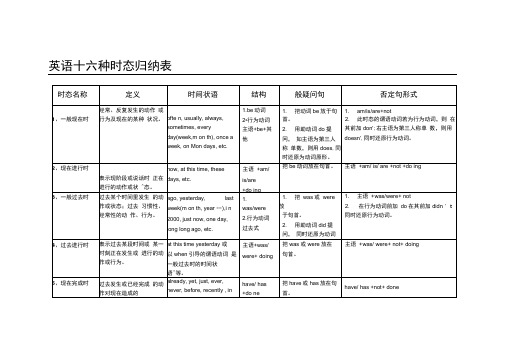
week(m on th, year…),i n 2000, just now, one day, long long ago, etc.
1.
was/were
2.行为动词
过去式
1.把was或were放
于句首。
2.用助动词did提问, 同时还原为动词原 形。
1.主语+was/were+ not
表示现阶段或说话时 正在进行的动作或状 ^态。
now, at this time, these days, etc.
主语+am/ is/are
+do ing
把be动词放在句首。
主语+am/ is/ are +not +do ing
3、一般过去时
过去某个时间里发生 的动作或状态;过去 习惯性、经常性的动 作、行为。
1.would+do
2.was/ were going to +do
1.would提到句首。
2.was或were放于 句首。
1.would+no t+do
2.was/were +not+ going to +do
9、一般过去将 来时
立足于过去某一时刻, 从过去看将来,常用于 宾语从句中
The next day(m orning. Year)
The followi ng mon th (week) etc
1,Was/were+ going to+do
2,would/shoul d+do+其他
1,Was/were放于句 首,
2,would/should提到 句首
英语十二种时态归纳表
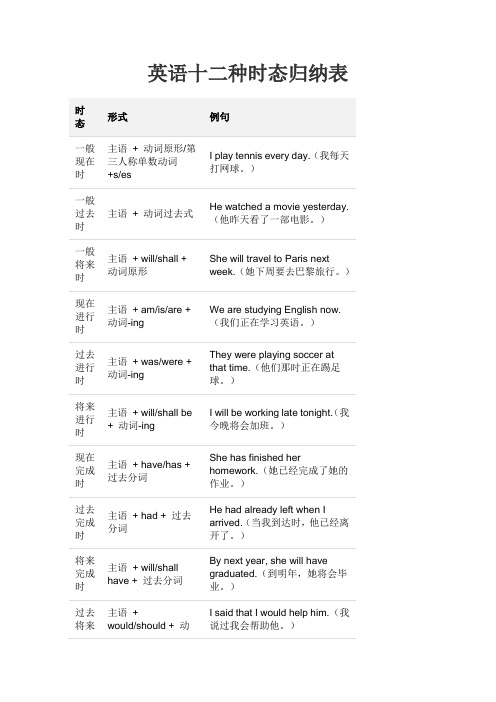
英语十二种时态归纳表时态形式例句一般现在时主语+ 动词原形/第三人称单数动词+s/esI play tennis every day.(我每天打网球。
)一般过去时主语+ 动词过去式He watched a movie yesterday.(他昨天看了一部电影。
)一般将来时主语+ will/shall +动词原形She will travel to Paris nextweek.(她下周要去巴黎旅行。
)现在进行时主语+ am/is/are +动词-ingWe are studying English now.(我们正在学习英语。
)过去进行时主语+ was/were +动词-ingThey were playing soccer atthat time.(他们那时正在踢足球。
)将来进行时主语+ will/shall be+ 动词-ingI will be working late tonight.(我今晚将会加班。
)现在完成时主语+ have/has +过去分词She has finished herhomework.(她已经完成了她的作业。
)过去完成时主语+ had + 过去分词He had already left when Iarrived.(当我到达时,他已经离开了。
)将来完成时主语+ will/shallhave + 过去分词By next year, she will havegraduated.(到明年,她将会毕业。
)过去将来主语+would/should + 动I said that I would help him.(我说过我会帮助他。
)时词原形虚拟语气主语+ should/wereto + 动词原形If I were taller, I could reach thetop shelf.(如果我个子高一点,我就能够够到顶层货架了。
)情态动词主语+ 情态动词+动词原形You should study harder.(你应该更努力学习。
英语八大时态总结一览表
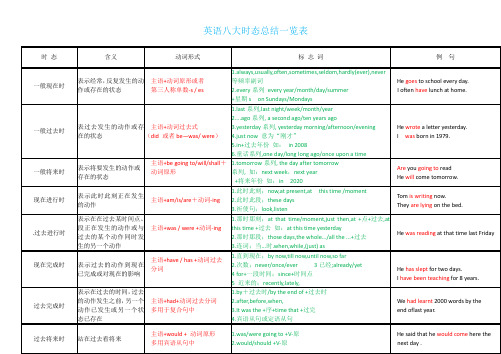
3.连词;当...时.when,while,(just) as
Hewas readingat that timelast Friday
现在完成时
表示过去的动作到现在已完成或对现在的影响
主语+have / has +动词过去
时态
含义
动词形式
标志词
例句
一般现在时
表示经常,反复发生的动作或存在的状态
主语+动词原形或者
第三人称单数-s / es
1.always,usually,often,sometimes,seldom,hardly(ever),never等频率副词
2.every系列 every year/month/day/summer
Tomis writingnow.
Theyare lyingon the bed.
.过去进行时
表示在在过去某时间点、段正在发生的动作或与过去的某个动作同时发生的另一个动作
主语+was / were +动词-ing
1.那时那刻;at that time/moment,just then,at +点+过去,at this time +过去 如:at this time yesterday
2....ago系列, a second ago/ten years ago
3.yesterday系列, yesterday morning/afternoon/evening
4.just now 意为“刚才”
5.in+过去年份 如: in 2008
6.童话系列,one day/long long ago/once upon a time
八种常见英语动词时态简表

/years,
up to now, till now
by +过去的时间点,
by the end of +过去的时间点, before/after+过
去的时间点,
till then
表示现在正在发生或正在进行的动作。
表示过去某个时间发生的动作或存在的状态。
表示在过去某一时刻或某一段时间内正在发生或进行的动作。
表示将来某个时间要发生的动作或存在的状态,也表示将来经常或反复发生的动作或状态。
表示从过去开始一直持续到现在的动作,并且(有可能)还将持续下去。
表示(1)过去发生或已经完成的动作对现在造成的影响或后果;(2)从过去某一时间开始并一直持续到现在的动作或状态。
3. am/is/are +现在分词
助动词have/has been
+动词ing
助动词have/has
+过去分词
助动词had
+过去分词
常见
标志性
词语
often
usually
always
sometimes
hardlyever
never
everyday
on Sundays
now
look
listen
ago,yesterday,
动词的八种时态简明一览表时态类别一般现在时现在进行时一般过去时过去进行时一般将来时现在完成进行时现在完成时过去完成时概念表示经常发生的或习惯性的动作或目前的状态
动词的八种时态简明一览表
时态
类别
一般现在时
现在进行时
一般过去时
过去进行时
一般将来时
动词时态总结表

1 / 3语法填空1. Failure _____(be) the mother of success.2. The teacher said that the earth _______(go) round the sun.3. Daydreams _____(be) often very simple and direct, quite unlike sleep dreams, which may be hard to understand.4. Secondary school in the U.S.A. usually _________(cover) seven years, grades six to twelve.6.I’ll participate in the game if it _______ (do) rain.7. I’ll let him know as soon as he ________ (come).8. Remember to send me a photo of us next time you ______ (write) to me.9. The train _________(leave) at 4:30 p.m.10. I can guess you were in a hurry. You ________ (wear) your coat inside out.11. The workers ___________ (build) a garden these days.12. The book _______(belong) to her.13. He ______ (look) for a house when he saw an advertisement in a newspaper one day.改错1 He watching TV now .2. Look! The boys is playing football.3. The students are swiming in the pool.4. Now I am liking walking.2 / 35. He taught English for ten years.6. He has died for two years.7. They have already drove to the village.8. She planed to study abroad.9. He said he will fly a kite that afternoon.10. When the time came for me to say goodbye to my friends in the village, I wanted to reward the old woman for the trouble I caused her. But she refused.3 / 3。
- 1、下载文档前请自行甄别文档内容的完整性,平台不提供额外的编辑、内容补充、找答案等附加服务。
- 2、"仅部分预览"的文档,不可在线预览部分如存在完整性等问题,可反馈申请退款(可完整预览的文档不适用该条件!)。
- 3、如文档侵犯您的权益,请联系客服反馈,我们会尽快为您处理(人工客服工作时间:9:00-18:30)。
英语动词时态归纳总结对照表名称用法动词形式(以do为例) 常用时间状语例句一般现在时1.现在的状态2.经常性或习惯性的动作3.主语具备的性格或能力I/We/You/They do...He/She/It does...in the morning/afternoon/morningevery day/morning/Sundayon Sun dayalways usually oftensometimesis twelve.get up at 6:30 every day.likes swimming.一般过去时1.过去某时发生的动作或存在的状态2.过去经常或反复发生的动作I/We did...You did...He/She/It did...They did...yesterday(morning/afternoon)last night/Sunday in 1990two days ago alwaysusually often sometimesgot up at 6:30 yesterday.always went to work bybus last year.一般将来时1.将来某时间要发生的动或存在的状态2.将来经常或反复发生的动作I shall do...I'm going to do...We/You/They/He/She/It will do...We/You/They aregoingto do...He/She/It is going todo...tomorrow(morning/afternoon/evening)next year/month/weekwill go to my home townnext week.'ll come to see you everySunday.'m going to swim tomorrowafternoon.现在进行时现在或当前一段时间内正在进行或发生的动作I'm doing...He/She/It is doing...We/You/They aredoing...nowis watering the flowers.they working now?are listening to theteacher.过去进行时过去某一时刻或某一段正在进行的动作I/He/She/It was doing...We/You/They weredoing....this time yesterdayat ten o'clock yesterdayat that timewhen he came backwere reading in class thistime yesterdaywas drawing a picturewhen the teachercame in.现在1.过去发生或已经完成的某He/She/It has done...We/You/They havealready just before neverfor three years've already posted theletter.完成时一动作对现在造成的影响或结果2.表示过去已经开始并持续到现在的动作或状态done...since 1990this morningthese dayshave known each other forten years.lived here since 1997.you ever been to Beijing?过去完成时过去某一时间前已经发后的动作或状态I/We/You/He/She/Ithad done…….by the end of…when+一般过去时before+一般过去时had learned 2000 words bythe end of last term.I got out,the bus hadalready left.现在完成进行时现在以前的一段时间里一直进行的动作,这个运作可能仍在进行,也可能继续进行下去I/We/You/They havebeen doing….He/She/It has beendoing….since nine o’clockfor five hourshave been skating for fivehours.has been skating sincenine o’clock..英语时态专项练习1、一般现在时。
通常用“usually, often, every day, sometimes”。
一般现在时基本用法介绍一、一般现在时的功能1.表示事物或人物的特征、状态。
如:The sky is blue.天空是蓝色的。
2.表示经常性或习惯性的动作。
如:I get up at six every day.我每天六点起床。
3.表示客观现实。
如:The earth goes around the sun.地球绕着太阳转。
二、一般现在时的构成:肯定句:1).主语+系动词 be(is, am, are )+名词(形容词,介词短语)2) .其他主语+动词原形+其它第三人称单数+动词-s+其它如:I am a boy.我是一个男孩。
We study English.我们学习英语。
Mary likes Chinese.玛丽喜欢汉语。
三、一般现在时的变化否定句:1)主语+ be (is,am,are)+ not +其它。
如:He is not a worker.他不是工人。
2)其他主语+do not(do n’t)动词原形+其它I don't like bread第三人称单数+does not(doesn’t)动词原形+其它He doesn't often play.一般疑问句:1)Be(Is,Are) +主语+其它?如:-Are you a student? -Yes. I am. / No, I'm not.2)Do其他主语+动词原形+其它?Does+第三人称单数+动词原形+其它+?注意:遇I/we—you, my—your, some—any.Does she go to work by bike? - Yes, she does. / No, she doesn't.Do you often play football?- Yes, I do. / No, I don't.特殊疑问句:疑问词+一般疑问句。
如:Where is my bike?How does your father go to work?2、现在进行时。
通常用“now/look/listen”.1.现在进行时表示现在正在进行或发生的动作,也可表示当前一段时间内的活动或现阶段正在进行的动作。
2.现在进行时的结构:.肯定句:主语+be(is,am,are ) +动词现在分词-ingeg: I am(not) doing my homework.You/We/They are(not) reading.He/She/It is(not) eating.否定句:主语+be(is,am,are )+not + 动词现在分词-ing一般疑问句:Is(Are)+主语+动词现在分词-ing?特殊疑问:疑问词+ be + 主语 + 动词ing?3.动词加ing的变化规则1)一般情况下,直接加ing,如:cook-cooking2)以不发音的e结尾,去e加ing,如:make-making, taste-tasting3)如果末尾是一个元音字母和一个辅音字母,双写末尾的辅音字母,再加ing,如:run-running, stop-stopping,swim—swimming3、一般过去时态一般过去时通常用“a moment ago, just now, yesterday, last…”等。
1.一般过去时表示过去某个时间发生的动作或存在的状态,常和表示过去的时间状语连用。
一般过去时也表示过去经常或反复发生的动作感谢。
2.Be动词在一般过去时中的变化:⑴am 和is在一般过去时中变为was。
(was not=wasn’t)⑵are在一般过去时中变为were。
(were not=weren’t)⑶带有was或were的句子,其否定、疑问的变化和is, am, are一样,即否定句在was或were 后加not,一般疑问句把was或were调到句首。
3.行为动词的一般过去时变化肯定句(Positive)动词过去式 I went shopping last night.否定句(Negative) didn’t + 动词原形I didn’t go shopping last night.一般疑问句(Yes/No) Did …+ 动词原形…?Did you go shopping last night?特殊疑问句(wh-) What did…+ 动词原形…?What did you do last night?4.动词过去式的变化:规则动词的变化:一般动词+ed planted,watered,climbed以不发音的e结尾+d liked辅音字母加y结尾-y+ ied study—studied, cry- cried重读闭音节单词,末尾只有一个辅音字母双写最后一个字母+ed stop –stopped plan - planned不规则动词的变化:原形过去式原形过去式原形过去式原形过去式sweep swept teach taught have had go wentkeep kept think thought do did find foundsleep slept buy bought eat ate say saidfeel felt drink drank is/am was take tookread read give gave are were mean meantput put sing sang drive drove meet metcut cut begin began speak spoke make madelet let ring rang write wrote see sawfly flew run ran ride rode come camedraw drew sit sat hear heard tell toldgrow grew learn learned/ learnt get got know knew5.特殊疑问句:⑴疑问词+did+主语+动词原形?如: What did Jim do yesterday?⑵疑问词当主语时:疑问词+动词过去式?如:Who went to home yesterday?4、一般将来时概念:表示将要发生的动作或存在的状态及打算、计划或准备做某事。
